Animation 09 May 2011 06:57 am
Bad Animation
- Let’s just ramble on about animation. I don’t mean animated films, I mean animation. I don’t much like watching animated films these days. I haven’t seen much that I like among recent films. All those YouTube videos and student films on Cartoon Brew. There’s so much more chaff than wheat. I get enormously impatient and dismiss films quickly. I sat through the ASIFA East animation festival award winners and got to see a number of bad films, regardless of the fact that they’d won awards. (Despite all the unknowing comments on Cartoon Brew recently, there were quite a few films among the winners. The shortage was in the Independently produced films, which is not a problem with ASIFA East’s festival but with Independent film. There were two fine films among the winners – both had problems as well – and a lot of bad films. I don’t include Student films in this discussion.)
I saw a lot of problems with these films that had won. Let’s talk about a couple of these problems without naming the films. I don’t mean to pick on ASIFA East award winners; it’s just that some bad habits showed up among some of the winners. There was lots of bad writing, but that’s not going to be my main focus. I’m concerned about the animation.
Below are the frames from John Kricfalusi‘s site of one of his favorite run cycles:
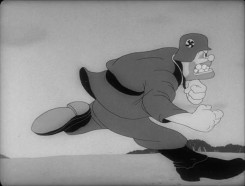 1
1 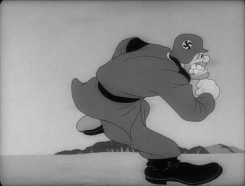 2
2
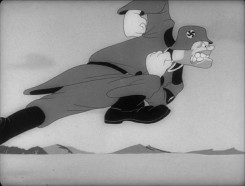 11
11 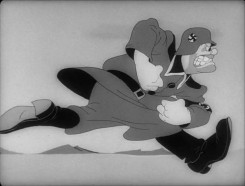 12
12
Though the original scene is and should be on ones,
I’ve exposed it on twos for the sake of my blog points.
The drawings above in a QT movie.
- I don’t think most people animating these days think of their drawings as characters – not really. How else could you explain the preponderance of half-walks? That is when you animate one leg crossing in front of the other, and you keep repeating this instead of then animating the back leg crossing. You’re doing half the number of drawings, but you’re showing your lack of interest in a character, rather than a graphic motion. This isn’t limited animation, it’s bad animation! It’s surprising that even in the silent days of animation, they didn’t take this crappy short cut. They didn’t really know what character animation was, back then, yet they had more concern for the characters than do the “animators” of today. It’s pathetic. Yet, I can count three times, in three different films, noticing this lousy stunt among the award winners. And you see it in so many of the new on-line films.
as it would be animated by today’s animator.
Students: ANIMATE BOTH LEGS! “Professionals,” you should be ashamed of yourselves.
- I’ve also noticed that there are a lot of films that are animated on fours. It’s not just that the animation is on fours (and believe me when I say that I can see every one of the frames on fours!), it’s that the animators don’t make the choice. They work in flash or some other program where they choose to animate solely on fours. This means they can’t go to threes, twos or, heaven forbid, ones when they have to. It also means they don’t properly know how to animate. Since all animation is about TIMING, and since you choose not to properly time your motions, you’ve given up the most important attribute in animation. It’s not good, and it’s a real disservice to your own learning abilities. You’ve chosen to stunt your growth.
There were many films done this way. One of them also included a lot of camera moves – also on fours. It was like a staccato zoom in or out. I felt like I was jumping in and out in stages and wanted to run out of the theater – or at least stop watching these award winners.
exposed on fours.
There was a Disney Action Analysis class where they discussed when things should be on ones, twos, threes or fours. The decision was, originally made, that animation should be NEVER exposed on fours. That is until it was shown that very slow moving animation, animation that required MANY drawings – when lines touched lines – could get away with fours. Of course, this has to do with full animation, and the limited type of animation done today can find many uses for fours, but there has to be a choice to go in and out of that choice. Limiting yourself to ONLY animating on fours means you choose to handicap your animation, and you’re not really developing character. You can’t be.
You’re, again, animating a graphic symbol not a living thing.
- Then there were the films that treated the characters with complete hostility by pulling insufferably nasty and inhuman stunts on the characters. This IS a fault of the writing and the directing more than the animation. I do have a complaint about scripts. Why do I, as an audience member, have to sit through these terrible actions and business on the screen? This was the case with at least three of the films. The younger generation seems to delight in rotten behaviour to their “characters” indicating more of a psychological problem in the filmmaker than a choice in service of the film. Believe me this wasn’t the case ten years ago. Terribe things might happen to Daffy or Elmer, but they weren’t as vile and in your face as they are today.
One film showed a lot of promise as far as the animation – the movement – was concerned, but the principal character lived through some horrible torture. And then the happy ending had big, bright, bubbly and cute Disneyesque drawing that was equally repugnant. The film was just so easy to dismiss – yet the animation, itself, moved fairly well and showed real knowledge on the part of the animator/director/writer. The film was tedious to sit through.
This is what we have today. Violence is the last bastion of the young filmmaker. Viva la freedom! Too bad it makes for horrible filmmaking! Impossible to sit through.
Unfortunately, I can’t make an example of this from the drawings John K posted above. Also unfortunately, the violence in his films has unwittingly helped to lead to this direction, albeit the cartoon violence in his films IS character driven and works. In the best spirit of Clampett or Avery. The superviolent activity in these newer films is just repulsive and has nothing to do with character. It isn’t necessarily John K’s fault, it’s just the way it is. We all affect each other, and that’s the society we have nowadays. Too bad.
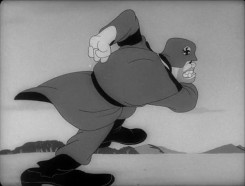
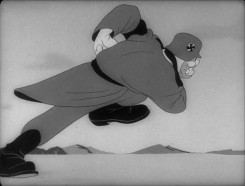
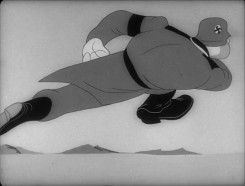
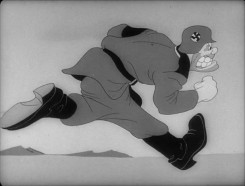
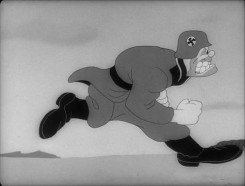
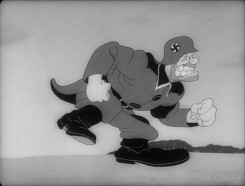

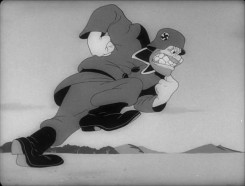

on 09 May 2011 at 8:25 am 1.Stephen Macquignon said …
Even though I thought that the animation was done well I couldn’t stop wondering why that type of cruelty was needed to be shown.
The unnecessary showing of violence is almost the only animation I can remember from the program.
It is unfortunate since there were other films I did enjoy and would like to remember them more clearly.
on 09 May 2011 at 8:40 am 2.Tim Rauch said …
Nice post Michael, from the heart and gut! I had to chuckle knowing that you are more than likely talking about my films (among others?) when describing your consternation with everything being on 4s. Perhaps you are right; I would certainly agree that I have a LOT more to learn and DO appreciate the generous thwack on the head
on 09 May 2011 at 8:47 am 3.Michael said …
I did think of your films, but not only your films. Another award winner was even more inappropriately on fours. The camera moves were hard to watch in that film. I thought I was seeing transmission dropout for a while, then realized that all the pans and zooms were on fours, too.
Your animation is so nearly brilliant that I wish you would give yourself more options. At least TRY doing it on threes.
on 09 May 2011 at 8:59 am 4.Tim Rauch said …
I’ve used 3s on some pre-StoryCorps stuff, definitely like it. I’ll have to challenge myself to incorporate more variations in frame rate with our next batch of SC stuff, so thanks for the note. I might also have to stop doing the half-cycles, which I didn’t do in either of the films screened at ASIFA but I did commit that sin twice in the past year.
on 09 May 2011 at 9:49 am 5.John Celestri said …
Michael, I think that what is lacking in younger animators is the ability to be patient. This is as important to an animator as the ability to draw. It takes patience to observe, analyze, mold, and refine the drawings necessary to put over an action. This could also be said of film scripts, etc.
It is also a lot easier to push the boundaries of taste, than to put together a solid story. This may also have been the case with young animators in the past, but it’s so much cheaper to produce and distribute (post on internet) a short film today, that thinking twice about what is being created doesn’t seem to come into consideration. Getting people talking about your video clip is what it’s all about.
on 09 May 2011 at 10:41 am 6.Mark said …
AMEN! In particular the virtual disappearance of “character animation.”. I fault the schools as much, and in some cases more than, the students. The focus or even emphasis on character animation has virtually disappeared from schools like CalArts and Sheridan. Both still produce a handful of students who excel at character work–but it’s often by their own dogged interest than anything. Most schools are interested in paying the bills by accepting lots of students whose parents are more interested in their child getting a job than the intense, detailed work required to learn character animation. Understandable–but misguided. And the schools are all too happy to respond to the parents (who control the purse strings) rather than the students.
on 09 May 2011 at 11:01 am 7.Eric Noble said …
Very interesting post Mr. Sporn. This has definitely given me a lot to think about. A lot of younger animators should be coming to this site for your advice. They might learn something.
on 09 May 2011 at 11:27 am 8.The Gee said …
I don’t think I have seen any of the films from the ASIFA-E so I won’t comment on them.
But, on the violence…. call me a wimp but I try to avoid animating blood just because only certain types of cartoons may require blood. Squash and stretch should be more than enough for funny, cartoon violence. Anything more should be solids or zip lines or stars .
Anyway, recently I have seen a lot of anime and what I watched seems to relish in blood spraying FX animation. All of it was violent. Not being well-versed in anime, I realize it is just as influential as feature animation or live action comedy.
So I guess I’m wondering is it violence for the sake of violence, for shock value or for the sake of humor, for gags?
As for the stuff on fours: are these talky cartoons, chatty ones?
on 09 May 2011 at 11:33 am 9.Uli Meyer said …
In regards to character animation I have to agree with you (I’m not talking about low budget jobs here, but people’s own films). Having started my professional career at Dick William’s studio, I am used to doing most of my animation on ones and occasionally twos. I can’t watch anything that is done on 3s or 4s, no matter how tight the spacing, to my eyes that simply doesn’t read as movement but looks like a badly timed pose test, never mind full character animation. If it was possible to do top notch character animation with six drawings per second, they would have done that a long time ago. I’m not saying everything needs to be on 24 drawings per second, but a good mix of ones and twos and strong, readable poses (and holds) is where it is at, always has been. And those half cycles (on 4s!) can’t be anything but laziness and a complete disregard for movement analysis and its interpretation (please don’t call it ‘breaking the rules’). Animation is hard work and if more films were executed properly, maybe the writing would improve too. You’d want to be extra sure the story works before creating all that work.
on 09 May 2011 at 11:49 am 10.Doug said …
It warms my creative heart to see a professional like Mr Rauch take constructive criticism from another professional like Mr Sporn. I agree, young animators should come here for the advice, but they should also come here to witness what makes a person a professional – that is the ability to have one’s work evaluated honestly, do the necessary soul-searching and hard work of applying that criticism and then making changes to one’s way of working. Great and informative post Michael! Way to stick your neck out there, I wish more people would do this.
on 09 May 2011 at 12:09 pm 11.morgan said …
Superb Blog.
on 09 May 2011 at 12:13 pm 12.David Nethery said …
You said what many of us are thinking. Many of the points you made in your musings on Bad Animation are points that I find myself repeating on a weekly basis in the animation classes I teach. (what’s with that thing of only animating HALF the walk cycle ? ! I cringe every time I see it in student work and I’m sad to hear that you are seeing it creep into “professional” films , too. Can’t they SEE how bad it looks ? ) Anyway, many a hearty “Hear! Hear!” and “Harumph! Harumph!” from my corner.
on 09 May 2011 at 12:31 pm 13.Ray Kosarin said …
Michael,
Thank you for a very important and (appropriately) bracing post.
Everything you’ve said about the half-hearted, half-though-out, half-finished animation that’s become almost the rule nowadays is important and, unfortunately, probably more in need of saying now than ever before.
But the very most important concern you talk about is animators’ treating their characters with ‘hostility’ and ‘pulling insufferably nasty and inhuman stunts on the characters’. If only this were just an animation problem instead of—-however dramatic this may sound–a social problem.
The recent, much publicized story of the Dreamworks animation artist, who worked on many cute animal films, accused of climbing into his neighbors’ yard and beating their dog to death–with a hammer–is horrifying: because of its unspeakable cruelty, but for another reason too. It points to an alarming and growing of unempathic, bullying, and ultimately violent behavior.
We are in real danger, as storytellers and as people, of confusing fake sentimentality with basic human empathy and scorning both. We are fast becoming more willing to be seen as cruel than to be seen as stupid or weak. But why should any of us wish to tell a story about someone we don’t care about? And if we think nothing of hurting (not fanciful coyote-hit-by-anvil-getting-accordion-body hurting, but really hurting) characters we think matter enough to tell stories about, how far away is that in our nature from not caring if we hurt a living creature or each other?
Bad animation is a pretty bad sin. But the heartlessness it brings to light is far worse. Not for film, but for the world.
on 09 May 2011 at 2:38 pm 14.Don Cox said …
Violence is as much a form of sentimentality as cute bunny rabbits – both are false emotions, not thought out.
Also, blood is very easy to animate. When I used to teach computer graphics to 16-year-olds, which included a bit of animation on DeLuxe Paint, I had to specifically forbid blood. Otherwise, what started as (for instance) a football game soon led to a character’s head coming off, and blood all over.
on 09 May 2011 at 3:55 pm 15.Tom Minton said …
It is possible that the animated ultra violence you describe was more directly inspired by the decade plus of sociopathic home entertainment that the computer gaming industry gleefully sold to a generation of young people. As carbon monoxide is more readily assimilated than oxygen by the human brain, so may be graphic, computer blandished bloodshed than John K’s Avery and Clampett-inspired 2D burlesque cartoon violence.
These are very interesting, and very literal, times.
on 09 May 2011 at 4:48 pm 16.Liesje said …
I’m horrified! I had no idea anyone would animate only half a walk-cycle! The importance and difficulty of nailing a great walk was hammered into me in college and I never would have even considered trying to pass off half as whole.
I can understand why – time, funds, etc. – but, really? Would 4 – 6 more drawings really kill you? And believe me, I’m not saying mine are any good (in fact, I’m sure most would prefer to see only half of them) but color me surprised!
on 09 May 2011 at 6:11 pm 17.Dave Levy said …
Great post, and I’ll take the lessons to heart. I’m trying to vow to not let my budgets show, however small. Liesje’s right, it’s only 4-6 more drawings.
Dave
on 09 May 2011 at 6:31 pm 18.James Nethery said …
The half-walk cycle thing makes me laugh (and cry).
Maybe it’s because my dad (David) really emphasized that to me when I was younger when I was doing my first little animation tests. It’s just one of those things I KNEW in the beginning before I even started doing real animation… so it seems weird to me that people don’t get that.
Animation Mentor pounded the “DO A FULL CYCLE” rule into my head as well in the very first semester.
I’m no master at animating walks by any means but it always astounds me when I hear about this kind of thing coming from so-called “professionals”. That’s “Animation 101″ right there. In theory, it’s not a hard thing to grasp. That shouldn’t be cropping up in “professional” work let alone student work.
on 10 May 2011 at 4:53 am 19.slowtiger said …
On “animating on 4′s”: just one name – Bill Plympton. Are his films unbearable to watch as well? I don’t think so.
In animation software forums I often have to explain the difference between 12 fps and “on 2′s” – for many beginners these are he same. Bashing Flash isn’t necessary here, it’s totally possible to animate dynamically in there.
There are several graphic styles where a “half cycle” is good enough, and for background characters in the distance it would be overkill to do full cycles for all. If I complain over a half cycle I also have to explain perspective (and lens width), but it’s not a general rule to be applied everywhere.
on 10 May 2011 at 7:47 am 20.Michael said …
I didn’t bash FLASH. I said, “They work in flash or some other program where they choose to animate solely on fours. This means they can’t go to threes, twos or, heaven forbid, ones when they have to.”
This means that they set that program so they can ONLY work on fours (or on twos.) This means you have few options to break out of fours or twos to learn about TIMING – which is all animation is about.
Bill Plympton animates on fives or sixes. He also has animated on ones. He doesn’t limit himself to a program that forces him to decide. That’s his style and it works for him. (As an artist, he has also never done a half walk cycle – I’ve seen all his films.)
The Rauch brothers also use fours – only. Tim is an excellent animator and learns more with every film. They make the fours work for their films, but so early in their career as animators to limit themselves ONLY TO FOURS means they’re stunting their growth re TIMING.
A half-walk cycle rarely works – even graphically. I can only think of one UPA film that used it to their end. They made a wheel of legs that turned around under the character’s work. They didn’t develop a character; they developed a style.
on 10 May 2011 at 7:48 am 21.Uli Meyer said …
A “half cycle” is never good enough, no matter how distant the character or what graphic style. Anything half done, not finished, should not be good enough. I simply don’t understand that kind of thinking.
on 10 May 2011 at 8:51 am 22.John Celestri said …
By definition, a cycle is repeated action…over and over and over again. So, to me, doing only HALF a cycle flags the artist/animator as being downright lazy or ignorant of the laws of motion (and, if so, is NOT an animator). The term “good enough” should only apply in the case of giving one’s all and not having enough time to fine tune an action. Don’t tell me you don’t have the time to complete a full two step cycle.
on 10 May 2011 at 10:32 am 23.The Gee said …
Half-cycles aside, Michael brought up UPA in how it sometimes executed walk cycles….what about Melendez’ Peanuts cycles? Depending upon the design, the character and the effect, a walk cycle doesn’t need to be 9 or 12 frames. Doing what works best matters.
Obviously you can vary and should vary the animation on ones, twos, threes, etc when it works. You can even have the variations within a scene. But, by bring up Plympton brings up an ever present constant:
It Depends.
Obviously, not every cartoon is going to be the same, some may not have cycles at all, some may not have pans, some might not have “camera moves” at all. Knowing how to make the most effective choices and executing them–showing your work and nailing the best result– is what seems to be emphasized here.
And, I think by half-cycles maybe it is just better to call them half-a**ed cycles. Obviously an incomplete, ineffective one does repeat and by definition would still be a cycle.
on 10 May 2011 at 1:57 pm 24.George Griffin said …
There’s a lot of indignation in this thread, so I just want to second the minority opinion of “showtiger,” up to a point. Plympton made fewer drawings work and it was not a decision based on narrative or character; it was experimental animation; it did break the rules; it let the scratchy lines move slower and not distract. A cycle is anything that’s repeated. The running Nazi gained some interesting qualities with fewer drawings: his head is obsessively facing forward to emphasize his menace, not twisting to the side on the stride; and the crazy legs give him a loping kind of nutty asymmetry.
Advice to students: Forget about “good” or “bad.” Just think about your objective, your time base, your momentary design and how it will flow or jerk in time. Maybe that’s why I don’t teach animation any more?
GG